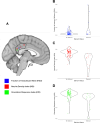This is a preprint.
Predilection for Perplexion: Preoperative microstructural damage is linked to postoperative delirium
- PMID: 39830255
- PMCID: PMC11741491
- DOI: 10.1101/2025.01.08.24319243
Predilection for Perplexion: Preoperative microstructural damage is linked to postoperative delirium
Abstract
Postoperative delirium is the most common postsurgical complication in older adults and is associated with an increased risk of long-term cognitive decline and Alzheimer's disease (AD) and related dementias (ADRD). However, the neurological basis of this increased risk-whether postoperative delirium unmasks latent preoperative pathology or leads to AD-relevant pathology after perioperative brain injury-remains unclear. Recent advancements in neuroimaging techniques now enable the detection of subtle brain features or damage that may underlie clinical symptoms. Among these, Neurite Orientation Dispersion and Density Imaging (NODDI) can help identify microstructural brain damage, even in the absence of visible macro-anatomical abnormalities. To investigate potential brain microstructural abnormalities associated with postoperative delirium and cognitive function, we analyzed pre- and post-operative diffusion MRI data from 111 patients aged ≥60 years who underwent non-cardiac/non-intracranial surgery. Specifically, we investigated preoperative variation in diffusion metrics within the posterior cingulate cortex (PCC), a region in which prior work has identified glucose metabolism alterations in the delirious brain, and a key region in the early accumulation of amyloid beta (Aβ) in preclinical AD. We also examined the relationship of preoperative PCC NODDI abnormalities with preoperative cognitive function. Compared to patients who did not develop postoperative delirium (n=99), we found increased free water (FISO) and neurite density index (NDI) and decreased orientation dispersion index (ODI) in the dorsal PCC before surgery among those who later developed postoperative delirium (n=12). These FISO differences before surgery remained present at six weeks postoperatively, while these NDI and ODI differences did not. Preoperative dorsal PCC NDI and ODI values were also positively associated with preoperative attention/concentration performance, independent of age, education level, and global brain atrophy. Yet, these diffusion metrics were not correlated with cerebrospinal fluid Aβ positivity or levels. These results suggest that preoperative latent brain abnormalities within the dorsal PCC may underlie susceptibility to postoperative delirium, independent of AD-related (i.e., Aβ) neuropathology. Furthermore, these preoperative microstructural differences in the dorsal PCC were linked to preoperative deficits in attention/concentration, a core feature of postoperative delirium. Our findings highlight microstructural vulnerability within the PCC, a key region of the default mode network, as a neuroanatomic locus that can help explain the link between preoperative attention/concentration deficits and increased postoperative delirium risk among vulnerable older surgical patients.
Keywords: Postoperative delirium; atrophy; attention; diffusion-weighted imaging; neurite density.
Conflict of interest statement
Competing interests MB has received material support (i.e. EEG monitors) for a postoperative recovery study in older adults from Masimo, unrelated to this manuscript. MB and JB have also received legal consulting fees related to postoperative neurocognitive function in older adults. JB acknowledges receiving funding from Claret Medical, Inc. and CardioGard, Inc., both unrelated to this manuscript. HZ has served at scientific advisory boards and/or as a consultant for Abbvie, Acumen, Alector, Alzinova, ALZpath, Amylyx, Annexon, Apellis, Artery Therapeutics, AZTherapies, Cognito Therapeutics, CogRx, Denali, Eisai, Enigma, LabCorp, Merry Life, Nervgen, Novo Nordisk, Optoceutics, Passage Bio, Pinteon Therapeutics, Prothena, Quanterix, Red Abbey Labs, reMYND, Roche, Samumed, Siemens Healthineers, Triplet Therapeutics, and Wave, has given lectures sponsored by Alzecure, BioArctic, Biogen, Cellectricon, Fujirebio, Lilly, Novo Nordisk, Roche, and WebMD, and is a co-founder of Brain Biomarker Solutions in Gothenburg AB (BBS), which is a part of the GU Ventures Incubator Program (outside submitted work). The other authors have no relevant conflicts to disclose.
Figures





Similar articles
-
Evidence of Ongoing Cerebral Microstructural Reorganization in Children With Persisting Symptoms Following Mild Traumatic Brain Injury: A NODDI DTI Analysis.J Neurotrauma. 2024 Jan;41(1-2):41-58. doi: 10.1089/neu.2023.0196. Epub 2023 Nov 29. J Neurotrauma. 2024. PMID: 37885245
-
Application of neurite orientation dispersion and density imaging or diffusion tensor imaging to quantify the severity of cervical spondylotic myelopathy and to assess postoperative neurologic recovery.Spine J. 2018 Feb;18(2):268-275. doi: 10.1016/j.spinee.2017.07.007. Epub 2017 Jul 12. Spine J. 2018. PMID: 28711563
-
Age-related differences in white matter microstructure measured by advanced diffusion MRI in healthy older adults at risk for Alzheimer's disease.Aging Brain. 2022 Jan 25;2:100030. doi: 10.1016/j.nbas.2022.100030. eCollection 2022. Aging Brain. 2022. PMID: 36908893 Free PMC article.
-
A systematic review of microstructural abnormalities in multiple sclerosis detected with NODDI and DTI models of diffusion-weighted magnetic resonance imaging.Magn Reson Imaging. 2023 Dec;104:61-71. doi: 10.1016/j.mri.2023.09.010. Epub 2023 Sep 27. Magn Reson Imaging. 2023. PMID: 37775062
-
A Real-Time Neurophysiologic Stress Test for the Aging Brain: Novel Perioperative and ICU Applications of EEG in Older Surgical Patients.Neurotherapeutics. 2023 Jul;20(4):975-1000. doi: 10.1007/s13311-023-01401-4. Epub 2023 Jul 12. Neurotherapeutics. 2023. PMID: 37436580 Free PMC article. Review.
References
-
- Prevention CfDCa. Rate of discharges from short-stay hospitals, by age and first-listed diagnosis: United States, 2010. https://www.cdc.gov/nchs/data/nhds/3firstlisted/2010first3_rateage.pdf.
Publication types
Grants and funding
- K76 AG057022/AG/NIA NIH HHS/United States
- R01 HL130443/HL/NHLBI NIH HHS/United States
- U01 HL088942/HL/NHLBI NIH HHS/United States
- U01 AG050618/AG/NIA NIH HHS/United States
- R01 AG076903/AG/NIA NIH HHS/United States
- R01 AG073598/AG/NIA NIH HHS/United States
- F32 AG084167/AG/NIA NIH HHS/United States
- T32 GM008600/GM/NIGMS NIH HHS/United States
- K23 AG084898/AG/NIA NIH HHS/United States
- R03 AG050918/AG/NIA NIH HHS/United States
- R01 AG074185/AG/NIA NIH HHS/United States
- P30 AG072958/AG/NIA NIH HHS/United States
- P30 AG028716/AG/NIA NIH HHS/United States
LinkOut - more resources
Full Text Sources
